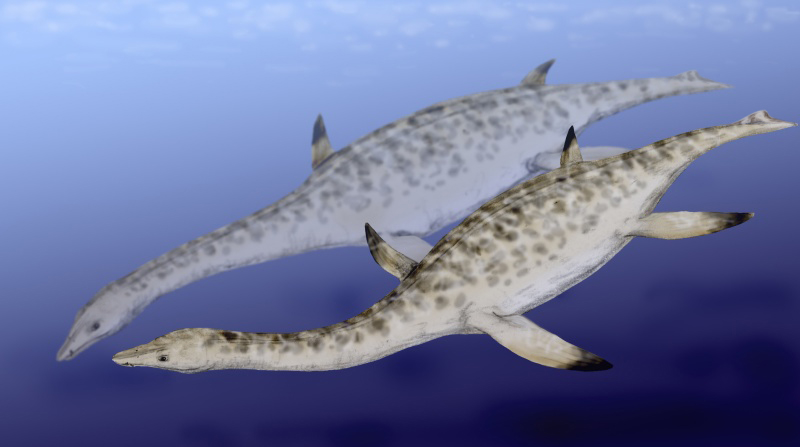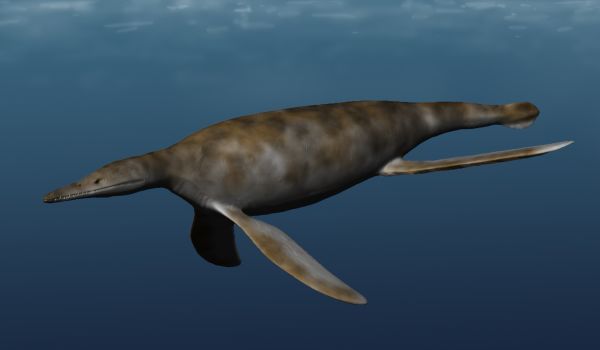|
Nichollssaura
''Nichollssaura'' is an extinct genus of leptocleidid plesiosaur from the Early Cretaceous Boreal Sea of North America. The type species is ''N. borealis'', found in the early Albian age Clearwater Formation near Fort McMurray, Alberta, Canada. ''Nichollssaura'' was a small plesiosaur, reaching in length and in body mass. It fills an approximate 40-million-year gap in the fossil record of North American plesiosaurs. The type specimen was discovered in one of Syncrude Canada Ltd.'s open-pit oilsand mines near Fort McMurray, Alberta, in 1994. The fossil is on display at the Royal Tyrrell Museum of Palaeontology, missing only the left forelimb and scapula, lost when the specimen was discovered accidentally by 100-ton electric shovel operators Greg Fisher and Lorne Cundal. Etymology The fossil, named after paleontological curator Dr. Betsy Nicholls, originally was named ''Nichollsia borealis'' but ''Nichollsia'' was already in use (preoccupied) by a genus of isopods. T ... [...More Info...] [...Related Items...] OR: [Wikipedia] [Google] [Baidu] |
Nichollssaura BW
''Nichollssaura'' is an extinct genus of leptocleidid plesiosaur from the Early Cretaceous Boreal Sea of North America. The type species is ''N. borealis'', found in the early Albian age Clearwater Formation near Fort McMurray, Alberta, Canada. ''Nichollssaura'' was a small plesiosaur, reaching in length and in body mass. It fills an approximate 40-million-year gap in the fossil record of North American plesiosaurs. The type specimen was discovered in one of Syncrude Canada Ltd.'s open-pit oilsand mines near Fort McMurray, Alberta, in 1994. The fossil is on display at the Royal Tyrrell Museum of Palaeontology, missing only the left forelimb and scapula, lost when the specimen was discovered accidentally by 100-ton electric shovel operators Greg Fisher and Lorne Cundal. Etymology The fossil, named after paleontological curator Dr. Betsy Nicholls, originally was named ''Nichollsia borealis'' but '' Nichollsia'' was already in use (preoccupied) by a genus of isopods ... [...More Info...] [...Related Items...] OR: [Wikipedia] [Google] [Baidu] |
List Of Plesiosaur Genera
This list of plesiosaurs is a comprehensive listing of all genera that have ever been included in the order Plesiosauria, excluding purely vernacular terms. The list includes all commonly accepted genera, but also genera that are now considered invalid, doubtful ('' nomen dubium''), or were not formally published ('' nomen nudum''), as well as junior synonyms of more established names, and genera that are no longer considered plesiosaurs. The list currently includes 201 genera. Scope and terminology There is no official, canonical list of plesiosaur genera but one of the most thorough attempts can be found on the Plesiosauria section of Mikko Haaramo's Phylogeny Archive; also pertinent is the Plesiosaur Genera section at Adam Stuart Smith's Plesiosaur Directory.See Smith, ''Plesiosaur Genera''. Naming conventions and terminology follow the International Code of Zoological Nomenclature. Technical terms used include: * Junior synonym: A name which describes the same taxon as a previo ... [...More Info...] [...Related Items...] OR: [Wikipedia] [Google] [Baidu] |
Leptocleididae
Leptocleididae is a family of small-sized plesiosaurs that lived during the Early Cretaceous period (early Berriasian to early Albian stage). They had small bodies with small heads and short necks. ''Leptocleidus'' and '' Umoonasaurus'' had round bodies and triangle-shaped heads. Leptocleidids have been found in what were shallow nearshore, freshwater and brackish habitats. Hilary F. Ketchum and Roger B. J. Benson (2010), transferred ''Brancasaurus'', ''Kaiwhekea'', '' Nichollssaura'' and ''Thililua ''Thililua'' is a genus of polycotylid plesiosaur, containing one species, ''T. longicollis''. Discovery The name ''Thililua'' is derived from that of an ancient aquatic god from local Berber mythology; ''longicollis'' refers to the animal's ...'' to this family. However, Ketchum and Benson (2011) reassigned ''Kaiwhekea'' and ''Thililua'' to their original positions, as an elasmosaurid and a polycotylid, respectively. Phylogeny Cladogram based on Ketchum and Benson (2011): ... [...More Info...] [...Related Items...] OR: [Wikipedia] [Google] [Baidu] |
2009 In Paleontology
Arthropods Cephalopods Three new species of extinct octopus, Octopoda discovered in 2009. The species – ''Keuppia hyperbolaris'', ''Keuppia levante'', and ''Styletoctopus annae'' – lived about 95 million years ago, and bear a strong resemblance to modern octopuses, suggesting that the Octopoda order has remained relatively unchanged for tens of millions of years. The fossils included evidence of cephalopod arm, arms, muscles, rows of suckers, cephalopod ink, ink, and internal gills. The discovery was made by a team led by Dirk Fuchs of the Freie University, which is located at Berlin, Germany.Rare fossil octopuses found NBC News, March 18, 2009 The fossils were found at Hakel and Hadjoula, Lebanon. [...More Info...] [...Related Items...] OR: [Wikipedia] [Google] [Baidu] |
Timeline Of Plesiosaur Research
This timeline of plesiosaur research is a chronologically ordered list of important fossil discoveries, controversies of interpretation, taxonomic revisions, and cultural portrayals of plesiosaurs, an order of marine reptiles that flourished during the Mesozoic Era. The first scientifically documented plesiosaur fossils were discovered during the early 19th century by Mary Anning. Plesiosaurs were actually discovered and described before dinosaurs. They were also among the first animals to be featured in artistic reconstructions of the ancient world, and therefore among the earliest prehistoric creatures to attract the attention of the lay public. Plesiosaurs were originally thought to be a kind of primitive transitional form between marine life and terrestrial reptiles. However, now plesiosaurs are recognized as highly derived marine reptiles descended from terrestrial ancestors. Early researchers thought that plesiosaurs laid eggs like most reptiles. They commonly imagined ples ... [...More Info...] [...Related Items...] OR: [Wikipedia] [Google] [Baidu] |
Plesiosaur
The Plesiosauria (; Greek: πλησίος, ''plesios'', meaning "near to" and ''sauros'', meaning "lizard") or plesiosaurs are an order or clade of extinct Mesozoic marine reptiles, belonging to the Sauropterygia. Plesiosaurs first appeared in the latest Triassic Period, possibly in the Rhaetian stage, about 203 million years ago. They became especially common during the Jurassic Period, thriving until their disappearance due to the Cretaceous–Paleogene extinction event at the end of the Cretaceous Period, about 66 million years ago. They had a worldwide oceanic distribution, and some species at least partly inhabited freshwater environments. Plesiosaurs were among the first fossil reptiles discovered. In the beginning of the nineteenth century, scientists realised how distinctive their build was and they were named as a separate order in 1835. The first plesiosaurian genus, the eponymous ''Plesiosaurus'', was named in 1821. Since then, more than a hundred valid ... [...More Info...] [...Related Items...] OR: [Wikipedia] [Google] [Baidu] |
2008 In Paleontology
Protozoa New taxa Plants Angiosperms Monocots Arthropoda Arachnids Insects Xiphosurans Fishes Bony fish Placoderms General research *Hilton & Grande redescribe the fossil mooneyes of western North America synonymizing the genus ''Eohiodon'' with ''Hiodon''. *Cicimurri, Paris, & Everhart describe a partial dentition from a Holocephali chimaeroid fish found in the Niobrara Chalk. Amphibians Jenkins, F. A., jr, Shubin, N. H., Gatesy, S. M., and Warren, A., 2008, Gerrothorax pulcherrimus from the Upper Triassic Fleming Fjord Formation of East Greenland and a reassessment of head lifting in temnospondyl feeding: Journal of Vertebrate Paleontology, v. 28, n. 4, p. 935-950. Newly named amphibians Archosaurs Newly named pseudosuchians Newly named pterosaurs Dinosaurs * Oviraptorosaurian eggs with embryonic skeletons are discovered for the first time in China. * Mongolian Late Jurassic theropod fossils are found for the first time. * A new study on ... [...More Info...] [...Related Items...] OR: [Wikipedia] [Google] [Baidu] |
Clearwater Formation
The Clearwater Formation is a Stratigraphy, stratigraphic unit of Early Cretaceous (Albian) Geochronology, age in the Western Canadian Sedimentary Basin, Western Canada Sedimentary Basin in northeastern Alberta, Canada. It was first defined by R.G. McConnell in 1893 and takes its name from the Clearwater River (Saskatchewan), Clearwater River near Fort McMurray. Impermeable marine shales in the Clearwater Formation provided part of the petroleum reservoir, trapping mechanism for the underlying Athabasca oil sands in the McMurray Formation. Sandstone units in the Clearwater Formation, including the Wabiskaw Member, can contain oilsand and Petroleum, heavy oil resources.Glass, D.J. (editor) 1997. Lexicon of Canadian Stratigraphy, vol. 4, Western Canada including eastern British Columbia, Alberta, Saskatchewan and southern Manitoba. Canadian Society of Petroleum Geologists, Calgary, 1423 p. on CD-ROM. . Nearly complete specimens of plesiosaurs and ichthyosaurs, as well as one Ankylosa ... [...More Info...] [...Related Items...] OR: [Wikipedia] [Google] [Baidu] |
Nichollsia
''Nichollsia'' is a genus of isopod crustaceans from India India, officially the Republic of India (Hindi: ), is a country in South Asia. It is the seventh-largest country by area, the second-most populous country, and the most populous democracy in the world. Bounded by the Indian Ocean on the so .... It comprises two species: *'' Nichollsia kashiensis'' Chopra & Tiwari, 1950 *'' Nichollsia menoni'' Tiwari, 1958 References Isopod genera {{isopod-stub ... [...More Info...] [...Related Items...] OR: [Wikipedia] [Google] [Baidu] |
Genus
Genus ( plural genera ) is a taxonomic rank used in the biological classification of extant taxon, living and fossil organisms as well as Virus classification#ICTV classification, viruses. In the hierarchy of biological classification, genus comes above species and below family (taxonomy), family. In binomial nomenclature, the genus name forms the first part of the binomial species name for each species within the genus. :E.g. ''Panthera leo'' (lion) and ''Panthera onca'' (jaguar) are two species within the genus ''Panthera''. ''Panthera'' is a genus within the family Felidae. The composition of a genus is determined by taxonomy (biology), taxonomists. The standards for genus classification are not strictly codified, so different authorities often produce different classifications for genera. There are some general practices used, however, including the idea that a newly defined genus should fulfill these three criteria to be descriptively useful: # monophyly – all descendants ... [...More Info...] [...Related Items...] OR: [Wikipedia] [Google] [Baidu] |
Royal Tyrrell Museum Of Palaeontology
The Royal Tyrrell Museum of Palaeontology (RTMP, and often referred to as the Royal Tyrrell Museum) is a palaeontology museum and research facility in Drumheller, Alberta, Canada. The museum was named in honour of Joseph Burr Tyrrell, and is situated within a designed by BCW Architects at Midland Provincial Park. Efforts to establish a palaeontology museum were announced by the provincial government in 1981, with the palaeontology program of the Provincial Museum of Alberta spun-off to help facilitate the creation of a palaeontology museum. After four years of preparation, the Tyrrell Museum of Palaeontology was opened in September 1985. The museum was later renamed the Royal Tyrrell Museum of Palaeontology in June 1990, following its bestowal of the title "royal" from Queen Elizabeth II. The museum's building was expanded twice in the 21st century. The first expansion was designed by BCW Architects, and was completed in 2003; while the second expansion was designed by Kasian Arc ... [...More Info...] [...Related Items...] OR: [Wikipedia] [Google] [Baidu] |
Isopod
Isopoda is an order of crustaceans that includes woodlice and their relatives. Isopods live in the sea, in fresh water, or on land. All have rigid, segmented exoskeletons, two pairs of antennae, seven pairs of jointed limbs on the thorax, and five pairs of branching appendages on the abdomen that are used in respiration. Females brood their young in a pouch under their thorax. Isopods have various feeding methods: some eat dead or decaying plant and animal matter, others are grazers, or filter feeders, a few are predators, and some are internal or external parasites, mostly of fish. Aquatic species mostly live on the seabed or bottom of freshwater bodies of water, but some taxa can swim for a short distance. Terrestrial forms move around by crawling and tend to be found in cool, moist places. Some species are able to roll themselves into a ball as a defense mechanism or to conserve moisture. There are over 10,000 identified species of isopod worldwide, with around 4,5 ... [...More Info...] [...Related Items...] OR: [Wikipedia] [Google] [Baidu] |








.jpg)